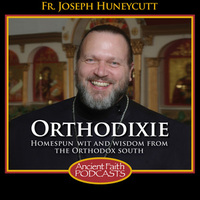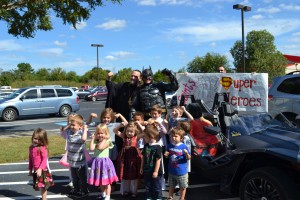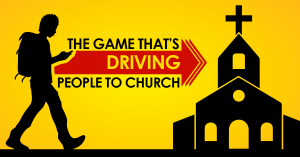It’s that time of year when secular society is preparing for the festival of Halloween. It’s no surprise, in our age of apostasy and relativism, that the true meaning of Halloween has been lost in mirthful superficiality and childish pranks. Halloween is regarded as one more occasion for a party without the most elementary curiosity about historical background, without any regard for religious and mystical consequences. It is hardly a surprise when we consider that the greatest feasts of Christianity such as Pascha and the Nativity of Christ, for which our ancestors prepared with fasting, prayers and tears, are now to so many, simply dates for eating, drinking and the exchanging of gifts. In the same spirit, the modern American public classifies Halloween with the debased and distorted celebrations of St Valentine and St Patrick. The former has been metamorphosed into a type of mid-winter Eros or Cupid, while the latter is generally taken to be a kind of Celtic Santa Claus.
Known also as All Hallows Eve, Allhallowe’n and Hallowmas, the feast of Halloween began in pre-Christian times. It was originally a Celtic festival celebrated widely among the peoples of the British Isles and northern France. These pagan peoples believed that life was born from death. Therefore they celebrated the beginning of the “new year” in the fall when, as they believed, the season of cold, darkness, decay and death began. On that night a certain deity whom they called Samhain, their Lord of Death, was honored at their New Year’s festival. On that night Samhain was believed to lead hosts of evil spirits into the world. Samhain is also identified as Samana, the dark Aryan god also known as the Grim Reaper.
On the eve of the festival, the Druids, who were the priests of the Celtic nature cult, instructed their people to extinguish all hearth fires and lights. A huge bonfire built from oak branches, which they believed to be sacred, was ignited in a high place. Upon this fire sacrifices of crops, animals and even human beings were burned as an offering in order to appease and cajole Samhain. It was also believed that Samhain, being pleased by their faithful offerings, allowed the souls of the dead to return to their homes for a festal visit on this day. Cold, dark creatures filled the night: evil witches, hobgoblins and evil pookas that appeared in the form of hideous black horses. Demons, fairies and ghouls roamed about as the doors of the burial mounds opened wide, allowing them free access to the world of living men. It is from this belief that the practice of wandering about in the dark dressed up in costumes imitating ghosts, hobgoblins, fairies, sprites, leprechauns, elves, brownies, smurfs, and other assorted demons, grew up. The living entered into fellowship and communion with the “dead” by what was, and still is, a ritual act of imitation; through costume and the activity of wandering about even as the souls of the dead were believed to wander.
The dialog of trick and treat is also an integral part of this system of beliefs and practices. It was believed that the souls of the dead who had entered into the world of darkness, decay and death, and therefore into total communion with and submission to Samhain, bore the affliction of great hunger on their festal visit. Out of this grew the practice of begging, which was a further ritual enactment and imitation of what the Celts believed to be the activities of the souls on their visit. Associated with this is the still further implication that if the souls of the dead were not appeased with “treats” (offerings) then the wrath and anger of Samhain, whose angels and servants the souls and imitators had become, would be unleased through a system of “tricks” (curses). By their vengeance crops were destroyed, cattle killed, milk soured and life in general was made miserable. As time went by, certain villagers were chosen to mystically take on the attributes and powers of the ghouls. These “mummers” as they were called, cavorted from house to house collecting the equivalent of protection money.
Saint Patrick, the patron saint of Ireland and other Celtic lands, stood in firm opposition to the Druid priests. After the call to extinguish all fires, St Patrick went to a hill and ignited a large signal fire which could be clearly seen by the chief priests. On orders, soldiers were sent to kill him, but through the power of God, he became invisible to them.
There are other practices associated with Halloween from which we should abstain. As was mentioned above, the faithful were to extinguish their fires and lights and gather around the fire of sacrifice. Because this was a sacred fire, it was from this that the fire of the new year was to be taken for the purpose of rekindling the hearth and lights at home. Vegetables (turnips) were hollowed out and carved in imitation of the dead and used to convey the new light and fire to the home where the lantern was left burning throughout the night. The use of a pumpkin Jack-O’Lantern involves celebration of and participation in the pagan festival of death.
Divination was also associated with this festival. The Druids would carefully watch the writhing of the sacrificial victims in the fire and from their death agonies would foretell the future of the village. After the fire had died out, the Druids examined the remains of the sacrifices in order to foretell, as they believed possible, the events of the coming year. Today all sorts of sorcery, fortune telling, divination, Ouija, games of chance — and more unfortunately — Satan worship and witchcraft are practiced.
In the days of the early Celtic Church, which was strictly Orthodox, the Holy Fathers attempted to counteract this pagan New Year festival by establishing the Feast of All Saints on the same day. (In the East the Feast of All Saints is celebrated on the Sunday following Pentecost). As is the custom of the Church, the faithful Christians attended a Vigil Service in the evening and in the morning a celebration of the Holy Eucharist. It is from this that the term Halloween developed. The word has its roots in the Old English of All Hallow E’en, i.e. the Eve commemorating all those who were hallowed (sanctified). However, the Church’s attempt to supplant this pagan festival [obviously] failed. The cultural (i.e., religious) aspects of Halloween have not been Christianized as have other symbols like Christmas trees, therefore the associations are not Christian at all, but remain pagan.
From an Orthodox Christian viewpoint, participation in Halloween practices at any level is idolatrous, a genuine betrayal of our God and our Holy Faith. To do so by dressing up and going out would be to willfully seek fellowship with the “dead” whose Lord is also known as Satan, the Evil One, who stands against God. Or, to participate by submission to the dialogue of “trick or treat” is to make offering, not to innocent little children, but to the Lord of Death, whom they unknowingly serve as proxy for the “dead” to whom none would likely pay respect.
According to the warnings of the Apostles and Holy Fathers, it is always wrong to approach and adopt anything in our secular American ethos thoughtlessly, naively and “like everybody else.” Halloween is not what it appears to be. Its seemingly innocent manifestations represent a memory of an ancient celebration deeply rooted in paganism and demonology and continues to be a form of idolatry in which Satan, the angel of death is worshipped.
— Edited from posts on the Orthodox List











